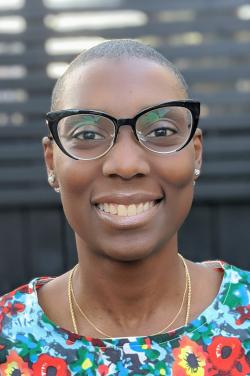Nicole Lavonne Smith-Johnson

Nicole Lavonne Smith-Johnson is a restorative justice practitioner, coach and trainer who specializes in anti-racism, racial justice, and equity and diversity training and consulting. She is a Morningside Center staff developer and a contributing writer for TeachableMoment.
Nicole is skilled in planning and executing healing and wellness events to raise social consciousness and build community. Prior to her work in restorative justice, Nicole was a dedicated New York City educator for two decades, teaching English, environmental science, and capoeira, and advocating for culturally responsible education.
Nicole holds a Masters in Urban Planning and International Development from New York University and a Bachelor in Psychology from Howard University. She resides in Brooklyn, New York, with her husband and two sons.
Nicole has a podcast, along with her restorative justice colleague Suzanne Hitchman, called BCWT (for "But Can We Work Together, Though?") about their years-long cross-racial collaboration.
Find out more about Nicole in this staff developer spotlight.
Students learn about Juneteenth, share family histories, and explore resources on the holiday and current efforts to erase aspects of American history and the role of Black people in it.
This lesson provides space for students to engage with the concept of intersectionality, and honor special women.
Students explore new angles on the life and ideas of Martin Luther King Jr., and consider their own responses and (re)commitments to justice.
Students share holiday traditions and experiences, and acknowledge the range of emotions that accompany the season.
This lesson for middle and high school students is intended to offer joy and inspiration, and the opportunity to be in community with peers.
Through readings, circle gatherings, and resources, students explore the history of Juneteenth and share their thoughts about community, liberation, and celebration.
Invite students to think about the power of storytelling, and make time for storytelling in your classroom.
This circle activity invites students to appreciate each other, using as inspiration the Zulu greeting Sawubona, which means “We see you.”
This lesson engages students in giving thanks for Breonna Taylor’s life, while offering space to share their impressions, feelings, experiences, and thoughts around the tragic circumstances of her death.
Students deepen their knowledge of the civil rights icon and listen to and share their thoughts and reflections.
This activity invites students to listen to and share music that can inspire and sustain them as they explore ways to battle oppression and push to survive and thrive during these challenging times.
This activity, aimed at caregivers and their middle or high-schoolers, provides a student-driven process for young people to think flexibly and creatively about their opportunities for learning during this period, formulate ideas, and follow through on them.
Students explore ways to creatively connect, show each other support, and display kindness amid this pandemic.
When is it right to share information about what we see as wrongdoing by others - and when is it meddling in someone else’s business? How do our morals and ideals affect our decisions to share information? Students consider these questions through this circle on social responsibility.
This lesson plan encourages high school students to explore the impact of racism as a central theme of Toni Morrison’s 1970 debut novel, The Bluest Eye. It includes suggestions for engaging students before, during, and after they read the book.